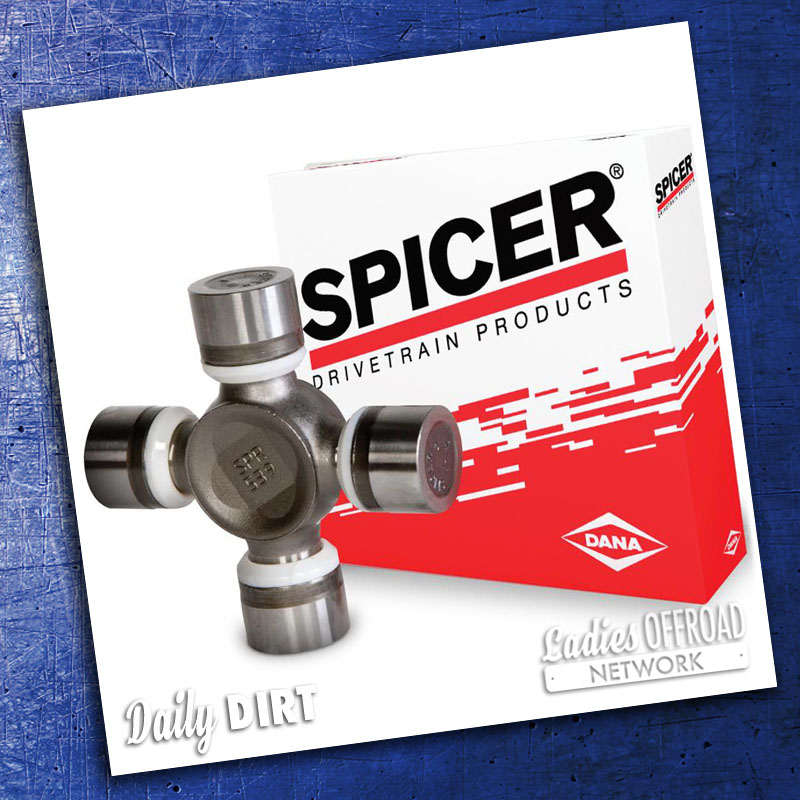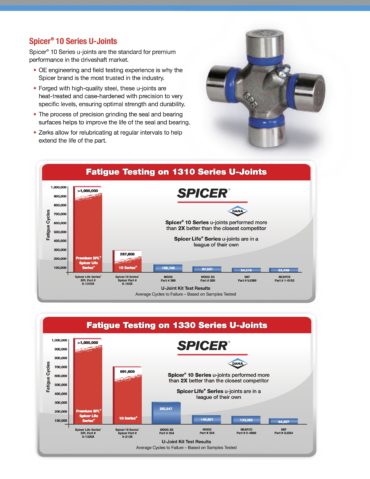There are a U-Joints, CV-Joints, Carden Joints and more as part of the driveline and axles of our vehicles. We caught up with Randall Speir, Marketing Manager for Spicer Parts and Dana Industries at King of the Hammers in reference to this months giveaway! He helps explain what a U-Joint is and then we expanded below to listing 5 ways you know a U-Joint is failing.
What is a U-Joint:
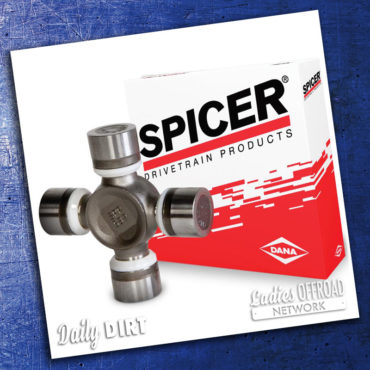 A U-Joint, universal joint or Carden Joint, is used in a position where flexibility is important to the vehicle or rotation motions are necessary. Most specifically on 4x4 and offroad vehicles, you will find u-joints attaching driveshafts and axle shafts. The structure to them is similar, but the sizes may be different. (vehicle dependent)
A U-Joint, universal joint or Carden Joint, is used in a position where flexibility is important to the vehicle or rotation motions are necessary. Most specifically on 4x4 and offroad vehicles, you will find u-joints attaching driveshafts and axle shafts. The structure to them is similar, but the sizes may be different. (vehicle dependent)
Commonly, there is a U-Joint at each end of the driveshaft. They allow the rear axle to move up and down in relation to the transmission without bending or snapping the driveshaft that connects them. Some driveshafts may even have a U-Joint or 2 (Double Carden Joint) in the center. There are also U-Joints commonly found on axles at the wheels.
A U-Joint has a lot of technology wrapped into a small part. It is a criss-cross shaped part with precision ground needle bearings, caps with triple lip seals, thrust washers, and grease.
Most U-Joints require maintenance being greased via zerk fittings, while new Spicer Joints are self-greasing. Assuming that U-joint dust seals are in top shape, you can follow Spicer’s on/off highway lubrication guidelines: 5,000-8,000 miles or every three months is the minimum. (Full Chart Here.) It should be more often if your vehicle is subject to extreme offroading including stream crossings, snowy highways and sand or silt desert washes.
Charlene Tip: A high-quality lube gun and clean grease are necessary for maintenance. When selecting U-joint and driveshaft greases, follow Spicer’s guidelines, avoiding heavier greases. Lube and Torque Chart HERE
A Deeper Dive Into Driveshafts and U-Joints via Bower Power Hour:
CLICK HERE to Read & Watch
5 Signs of a Failing U-Joint:
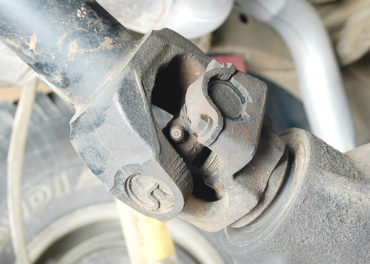 Squeaking Noise When Starting To Move:
Squeaking Noise When Starting To Move:
Failure of the needle bearings is the most common cause of wear, usually due to lack of lubrication. Since the bearing portion of each universal joint twists, a small amount with each rotation of the driveshaft (but always in the same location) the grease can evaporate, or be thrown out of the bearing cup. The bearing becomes dry, metal-to-metal contact is made, and the u-joint bearings will squeak as the drive shaft rotates. The squeak usually cannot be heard once the vehicle moves faster than 5-10 mph because of other vehicle noise. The squeak is a warning that the universal joint should be serviced.- “Clunk” with a Ringing Sound when Shifting from Drive to Reverse:
This noise usually indicates that the universal joint bearings have enough excess clearance to allow the driveshaft to rotate slightly, then come to a hard stop, when power is reversed. This can be the next stage of deterioration after having insufficient grease in the u-joint bearings. Greasing the u-joint bearings won’t reverse damage to the u-joint, but may extend its life somewhat. - Vibration Felt Throughout the Vehicle while Moving Forward at Speed
This vibration means that the universal joint bearings have now worn enough to allow the driveshaft to move outside its normal rotational path, causing imbalance and vibration. This will be a higher frequency vibration than that of an out-of-balance wheel for example, since the driveshaft turns 3-4 times faster than the wheels. The worn universal joint is now causing damage to other components of the vehicle – including the transmission. Replacement of the universal joint is in order at this point to prevent further damage. 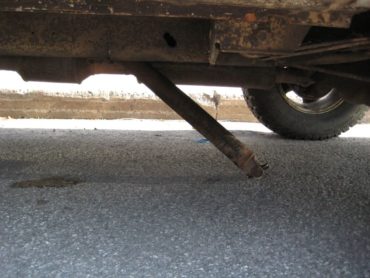 Transmission Fluid Leaks from the Rear of the Transmission
Transmission Fluid Leaks from the Rear of the Transmission
Transmission fluid leaking from the rear of the transmission is often the result of a badly worn universal joint. The vibration noted above has now worn the transmission bushing and damaged the transmission output shaft seal, which then leaks transmission fluid. If fluid is suspected of leaking from the transmission, the transmission should be inspected to determine the source of the leak, and the appropriate repair made.- Driveshaft Dislocated – Vehicle Cannot Move
You've probably seen it – a Jeep on the trail with the drive shaft lying under the vehicle, no longer attached to the transmission or rear axle. This is the ultimate failure mode for a universal joint – literally breaking, and allowing the drive shaft to drop to the ground. Repair at this point could include much more than the universal joint, possibly requiring full driveshaft replacement or more. Source
History of the Spicer U-Joint:
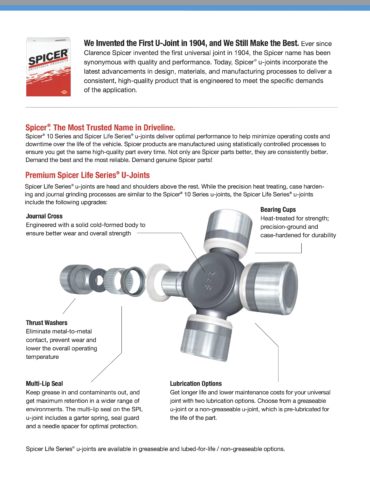 In April 1904, Clarence Spicer starts his company based on his patented invention of the encased universal joint, in Plainfield, New Jersey. This would replace the chain and sprocket in propelling a vehicle. Naming it Spicer Manufacturing Corporation.
In April 1904, Clarence Spicer starts his company based on his patented invention of the encased universal joint, in Plainfield, New Jersey. This would replace the chain and sprocket in propelling a vehicle. Naming it Spicer Manufacturing Corporation.
In 1914, Attorney Charles Dana purchased a controlling interest in Spicer Manufacturing Company. Decades later, in 1955, he says, "I don't know what would have happened if I hadn't gone into the Spicer company. Mr. Spicer had a joint that was really wanted by car and truck manufacturers. If it had gone off the market, I sometimes wonder what would have happened to the automotive industry."
In 1938, Clarence Spicer's last of 40 U.S. and French patents is issued Dec. 20, less than a year before he dies.
In 1946, Spicer Manufacturing Corporation is renamed Dana Corporation in recognition of Charles Dana's 32 years of leadership. Spicer becomes the brand name for the company's driveline products.
See the full 75+ year History Timeline: www.dana.com/corporate-pages/history
Author: Charlene Bower
Share with your Friends on Facebook:
Share with your Friends on Instagram:
Share with your Friends on Pinterest:


